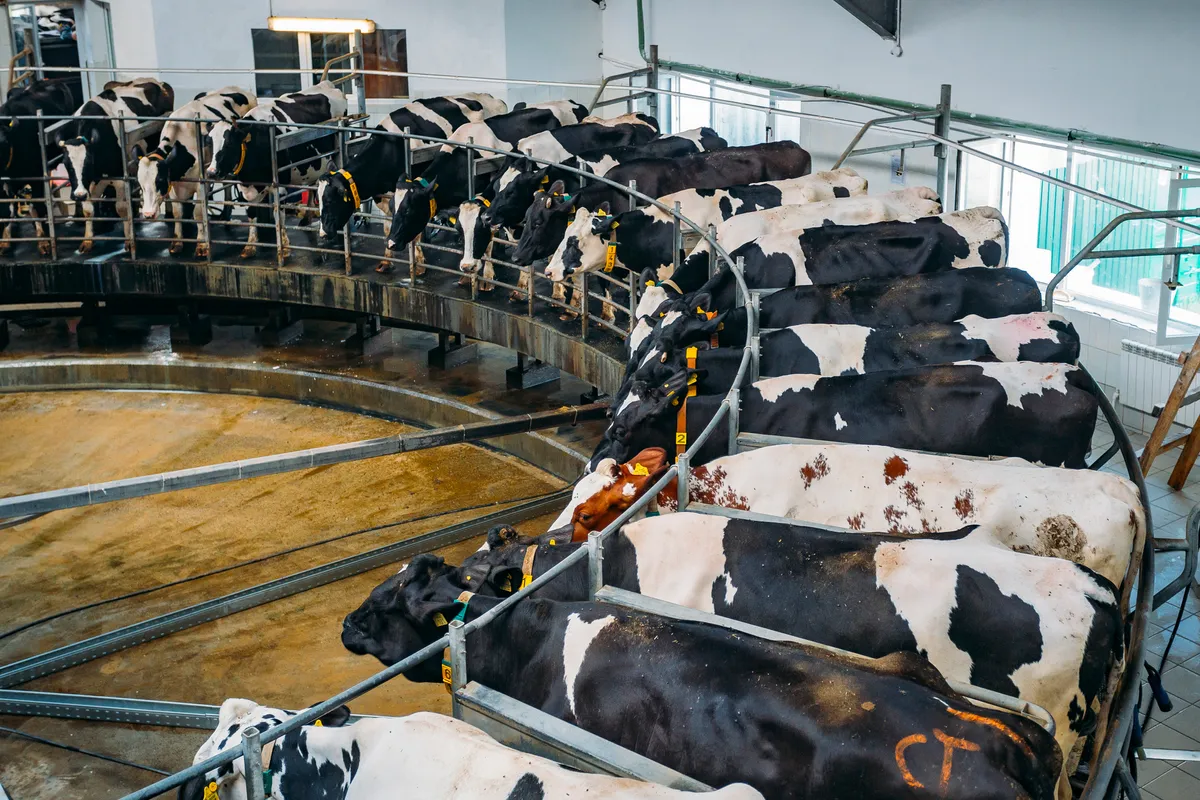We all know milk comes from cows, but do you know what goes into producing it for our needs?
Where does milk come from?
The story of where milk comes from concerns the biological science of natural milk production.
How do cows produce milk?
As mammals, cows need to give birth in order to produce milk and their gestation period is the same as ours: nine months.
As soon as she becomes pregnant, the cow’s mammary glands will prepare to make milk aided by the digestion and conversion of food.
Cattle are ruminants with four stomachs so, when they eat rough grass or pasture, they soften it by regurgitating it and chewing it again, or ruminating.
When you see cows lying down in the field working their jaws, they’ll be chewing the cud (semi-digested food) and they’re basically having their breakfast for the second time. It’s swallowed again and works its way through the other three stomachs being broken down with the vital nutrients being absorbed into the bloodstream and on to the udder.
In nature, once a cow has calved, she would suckle her own offspring, but over time we’ve refined a system of dairying where we’ve bred and developed cattle to produce more milk than one calf requires; the offspring are taken away and we milk the mothers for our own needs.
Eventually the cows will stop milking for a couple of months, known as drying off, which gives them a rest before they calve once more and the process happens all over again.
When female calves are born, it secures the next generation of the milking herd, but the fate of bull calves is more controversial.
Dairy cattle are generally bony and not particularly beefy, so they’re less desirable for the butcher. In the past, many bull calves were considered of no commercial use and killed shortly after calving.
Now though, there’s a strong drive for them to be reared for beef, a market for their meat has been created and farmers realise that dispatching them at birth is wrong and wasteful. So the shooting of male calves isn’t commonplace any more.
How are cows milked?

For centuries, cows have been milked by hand with the popular image being the milk maid perched on a wooden stool. In fact when my father was a boy, he milked cows by hand into a pail in exactly the same way.
Long before processing firms and superstores dominated the market and were able to dictate the price, quality and quantity of the milk supply, herds were small, yields were tiny and a lack of refrigeration meant business was strictly local.
In the farmhouse dairy, the milk was transferred into churns before being sold direct to the shop or householder. But since the Second World War, the milking process has changed beyond all recognition.
First bottling systems came in that led to the daily pints being delivered to the doorstep. Then, as dairies and processing plants developed, so milking machines became the norm, with clusters of labour-saving suction cups being attached to the cow’s teats.
The original individual milking machines made way for rotary parlours with the cows stepping on to a huge turntable allowing 60 animals to be milked at the same time.
Today robotic milking machine, an extraordinary piece of technology, allows the cows make their own way to the parlour, when they feel ready to be milked, and that’s when the clever stuff begins.
To make sure the cow actually needs to be fed or milked, an identity chip in their ear tag or attached to a pedometer is scanned.
If she’s good to go, she’ll be enticed with fodder cattle nuts and her udders washed automatically and scanned to locate the teats so the cluster of suction cups can attach. The on-board computer records the quantity and quality of the milk. It can even monitor the cow’s health and well being. It’s a brilliant example of technology working for the farmer and it certainly beats getting up at 4am.
How are dairy cows kept?
Milking herds are kept in a variety of ways and all have their respective pros and cons. First, there’s the traditional outdoor and grass-fed method. This is a very acceptable way of animal husbandry from the general public’s point of view; it appeals to the romantic idea of cows out on spring grass and, at the moment, free-range milk is gaining in popularity.
Many farmers will grow vegetables, roots and grass specifically to feed their cows, and all this adds weight to the argument that this type of milk tastes better. The negatives include the fact that both the farmer and the livestock are at the mercy of the great British weather. As we know, extremes of heat or cold can make certain animal diseases more prevalent and it means that the quality of the grass is incredibly variable.
Secondly there’s the indoor, intensive system. The upside is that these cows are the milk athletes of the dairy world, such as the Holsteins and other big, angular animals. They’re kept at a regulated temperature, they live on a total-measured ration (TMR) and every mouthful of maize, grass silage and grain they receive gives them exactly the right amount of minerals and nutrients they require to stay healthy and produce good quality milk.
The downsides for the farmer are that, being athletes, the animals have to be extremely well managed. It also needs considerable investment in buildings and equipment, while herds of more than 1,000 animals often require a full-time, on-site vet.
As ever, things are never clear-cut. The majority of British dairy farms combine the two systems with the cattle being fed outdoors in the spring and summer, then brought indoors for the winter once the weather gets cold.
So far, attempts to create what the media have dubbed Britain’s first ‘Mega Dairy’ have failed due to public opposition. Although there’s no official definition, ‘Mega Dairy’ is generally understood to mean highly intensive method of husbandry, in which a huge number of cows remain indoors all year round.
In the next 10 or 20 years, advancements in technology, science and genetics are certain to lead to bigger yields and lower costs while farmers, public opinion and legislation will drive up welfare standards. I think we’ll continue to see both the outdoor method and the more intensive systems used to produce milk at a price to satisfy the processors.

